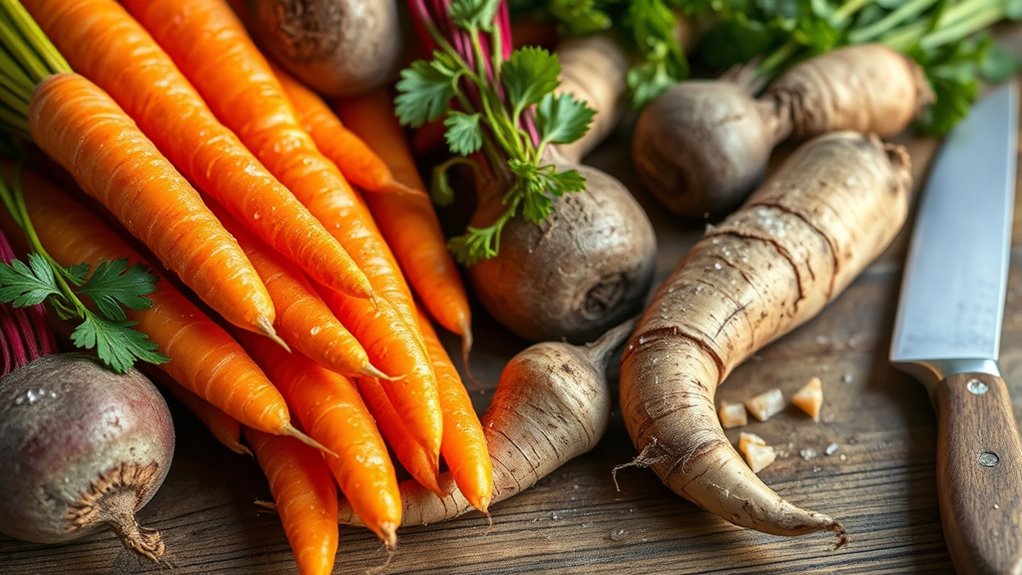Root-to-stem cooking helps you reduce food waste by using vegetable scraps like peels, stems, and tops that are often discarded. By doing this, you support sustainable farming practices, decrease the demand for resources, and lower greenhouse gas emissions from landfills. This approach also encourages you to create nutritious, flavorful meals from every part of your produce. If you keep exploring, you’ll find even more ways to make your impact positive and delicious.
Key Takeaways
- Reduces food waste by utilizing vegetable tops, peels, and stems that are typically discarded.
- Decreases organic waste sent to landfills, lowering methane emissions and environmental pollution.
- Promotes full-plant utilization, conserving resources like water, fertilizer, and land used in food production.
- Encourages sustainable farming practices by demanding the consumption of less commonly eaten plant parts.
- Minimizes environmental impact through creative meal prep, like making stock and smoothies from vegetable scraps.

Root-to-stem cooking is quickly gaining popularity because it allows you to make the most of every part of produce, reducing waste and saving money. When you embrace this approach, you’re actively participating in food waste reduction, which is crucial for lessening the environmental impact of food production. By using vegetable tops, peels, and stems that would typically be discarded, you help decrease the amount of organic waste ending up in landfills, which is a major contributor to methane emissions. This small shift in your cooking habits can have a significant positive impact on the environment.
Embrace root-to-stem cooking to reduce waste and support environmental sustainability.
In addition to reducing waste, root-to-stem cooking promotes nutritional optimization. Many parts of fruits and vegetables contain essential vitamins, minerals, and antioxidants that are often overlooked. For example, beet greens are packed with calcium and iron, while broccoli stems contain more fiber than the florets. By incorporating these overlooked parts into your meals, you increase the overall nutrient density of your diet. This means you get more value from your produce, making your groceries go further and supporting your health in the process.
Using the whole plant also encourages a more sustainable approach to food production. When farmers grow and harvest the entire plant, they reduce the need for additional resources like water, fertilizer, and land, which are often used to grow larger, more marketable parts. Your choice to cook root-to-stem not only minimizes waste in your kitchen but also supports more eco-friendly farming practices by creating demand for less commonly consumed parts. This, in turn, can influence the food industry to adopt more environmentally conscious practices and utilize more of what’s grown.
Furthermore, root-to-stem cooking can inspire you to get creative with your meals. You might experiment with making vegetable stock from peels and stems or blend vegetable tops into smoothies and pestos. These practices maximize the use of your ingredients and minimize the environmental footprint of your meals. As you become more mindful of how you handle produce, you’ll notice a reduction in the overall waste you generate, which directly benefits the environment. Incorporating HEPA filtration and other air purification methods into your home can further reduce indoor pollutants and allergens, supporting a healthier living space.
Frequently Asked Questions
How Does Root-To-Stem Cooking Reduce Food Waste?
Root-to-stem cooking helps you reduce food waste by using every part of vegetables and fruits, promoting waste minimization. You preserve more nutrients and extend your ingredients’ life, cutting down on discarded scraps. By cooking with stems, leaves, and peels that are often discarded, you make the most of your produce and contribute to a more sustainable kitchen. This approach encourages mindful consumption and lessens the amount of food that ends up in the trash.
What Are the Environmental Impacts of Traditional Versus Root-To-Stem Cooking?
You might think traditional cooking is simpler, but root-to-stem cooking offers a greener alternative. It reduces waste, supports sustainable farming, and preserves biodiversity by making full use of produce. While traditional methods often discard parts, root-to-stem cooking minimizes environmental harm, conserving resources and protecting ecosystems. Choosing this approach helps you lower your carbon footprint, promote sustainability, and enjoy diverse, nutritious meals that honor the planet’s health.
Can Root-To-Stem Cooking Help Conserve Water and Energy?
Yes, root-to-stem cooking helps you conserve water and energy. By using the entire vegetable, you reduce food waste and maximize resources, supporting sustainable farming practices. When you cook with less waste, you lower the demand for water and energy needed to produce, process, and dispose of food. This approach promotes water conservation, reduces your environmental footprint, and encourages more sustainable, mindful eating habits.
Are There Specific Crops That Benefit Most From Root-To-Stem Utilization?
You’ll find leafy greens and tuber crops benefit most from root-to-stem utilization. While leafy greens like kale and spinach often get discarded stems, cooking them fully reduces waste and boosts nutrition. Tuber crops such as carrots and beets are typically valued for their roots, but their greens and tops are also edible and underused. By embracing the whole plant, you maximize resources, reduce waste, and enjoy more flavors and nutrients.
How Does Root-To-Stem Cooking Influence Carbon Footprint Reduction?
Root-to-stem cooking helps reduce your carbon footprint by minimizing kitchen waste and promoting sustainable farming. When you use the entire plant, you cut down on food waste that would otherwise end up in landfills, producing methane. This practice encourages farmers to grow crops more sustainably, lowering overall emissions. By cooking this way, you actively support environmental conservation and lessen your impact on climate change.
Conclusion
By embracing root-to-stem cooking, you reduce waste, save resources, and honor nature’s gifts. You transform scraps into sustenance, minimize environmental impact, and maximize flavor. You embrace sustainability, support innovation, and foster mindful eating. You inspire change, nurture health, and protect the planet. So, start cooking smarter, waste less, and enjoy the countless benefits of nourishing your body and the earth—because every small choice makes a big difference.
Ilana has been a vegan for over 10 years. She originally made the switch for health reasons, but soon found herself becoming more and more passionate about the ethical and environmental implications of a vegan lifestyle. Ilana is the author of The Graceful Kitchen, a blog all about veganism. She loves to cook up delicious and nutritious vegan meals, and share her recipes with others who are interested in leading a cruelty-free life. Ilana is also a strong advocate for using whole foods as the foundation of a healthy diet, and believes that going vegan is one of the best ways to achieve this.















